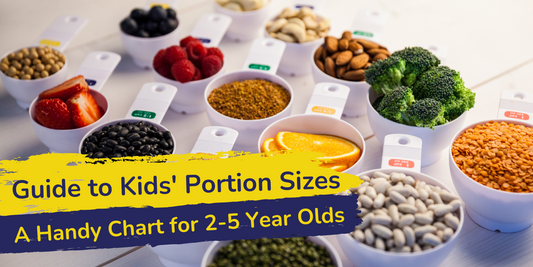
Beyond the Label: It's Not Just Picky Eating
If you've ever felt like mealtime is a battlefield, you’re not alone. Many parents struggle with their child’s selective eating habits, but picky eating isn’t just a one-size-fits-all challenge. It exists on a spectrum—ranging from mild hesitations to strong aversions. Some kids refuse to eat vegetables, others insist on only white foods, and some gag at the sight of anything unfamiliar. Sound familiar? Understanding why your little explorer is picky and what type they might be can make all the difference in turning stressful mealtimes into fun, food-filled adventures.
Understanding the Picky Eating Spectrum
Why Do Kids Become Picky Eaters?
There’s no single reason why a child becomes picky about food. Instead, a mix of biological, sensory, and psychological factors can shape their eating habits. Some of the most common reasons include:
• Natural Taste Sensitivity: Kids have more taste buds than adults, making certain flavors, like bitterness in greens, feel extra intense.
• Sensory Processing Differences: Some children are highly sensitive to textures, smells, and even colors.
• Independence & Control: As toddlers assert their independence, food refusal becomes one way to exercise control.
• Routine & Familiarity: Repetitive eating habits, known as "food jags," can make kids hesitant to try new things.
• Past Experiences: A negative experience—like choking or an upset stomach—can lead to fear of certain foods.
Is It Just a Phase?
For many kids, picky eating is a temporary phase, peaking between ages 2 and 6. During this time, taste preferences shift, and children explore their sense of control over food choices. However, for some, picky eating persists longer and may require strategic approaches to broaden their diet. Understanding your child’s unique food behaviors can help you tailor solutions that work best for them. Let’s meet the different types of picky eaters and how to navigate their mealtime challenges.
Meet the Picky Eaters: Decoding the 8 Different Types
1. The Regressor
Traits: Used to eat a variety of foods but suddenly rejects them.
Causes: Developmental changes, stress, or illness.
Tips: ✔️ Be patient—this is often temporary.
✔️ Continue offering their past favorites without forcing them.
✔️ Reintroduce foods in different ways (e.g., mashed, sliced, or with dips).
2. The Flavor-Hater
Traits: Dislikes strong, bitter, or unfamiliar flavors.
Causes: Natural sensitivity to taste.
Tips: ✔️ Start with mild flavors and gradually introduce stronger ones.
✔️ Serve food with familiar seasonings or dips (e.g., a sprinkle of cheese or a yogurt-based dip).
✔️ Use the "one bite rule"—encourage trying a small bite without pressure.
3. The Guzzler
Traits: Prefers drinking over eating.
Causes: Liquid calories fill them up.
Tips: ✔️ Limit milk or juice intake before meals.
✔️ Offer water instead of juice between meals.
✔️ Serve nutrient-dense smoothies to transition them toward solids.
4. The Super Feeler
Traits: Strong reactions to food textures.
Causes: Sensory sensitivities.
Tips: ✔️ Offer foods in a variety of textures (e.g., crunchy carrots vs. soft steamed carrots).
✔️ Let them explore food with their hands before tasting.
✔️ Avoid overwhelming them with too many textures on one plate.
5. The Gagger
Traits: Gags when trying new foods.
Causes: Strong sensory aversion or oral motor skill delays.
Tips: ✔️ Start with tiny portions and familiar textures.
✔️ Encourage small steps, like licking or touching the food first.
✔️ Seek professional guidance if gagging is frequent.
6. The Untouchable
Traits: Avoids messy foods and dislikes hands-on eating.
Causes: Sensory sensitivity to textures.
Tips: ✔️ Use utensils, skewers, or bento boxes for tidy eating.
✔️ Offer structured foods like sandwiches or veggie sticks.
✔️ Introduce sensory play outside of mealtime to reduce texture aversions.
7. The Neophobic
Traits: Fearful of trying new foods.
Causes: Evolutionary survival instinct, unfamiliarity.
Tips: ✔️ Offer new foods alongside familiar ones.
✔️ Let kids explore the new food without pressure.
✔️ Involve them in cooking and grocery shopping for a sense of control.
8. The Food Jag
Traits: Eats the same food repeatedly, then refuses it.
Causes: Comfort in routine, burnout from overexposure.
Tips: ✔️ Rotate meals to prevent burnout.
✔️ Introduce small changes to their favorites (e.g., adding new toppings).
✔️ Offer variety before they get tired of a single food.
When to Seek Professional Help
While picky eating is common, some signs warrant expert advice:
• Significant weight loss or growth concerns.
• Persistent gagging, choking, or vomiting.
• Extreme food restriction impacting nutrition.
Consulting a pediatrician or feeding specialist can provide personalized guidance to support your child’s nutritional needs.
Delicious Recipes for Picky Eaters
These fun and nutritious recipes can help turn hesitant eaters into enthusiastic explorers!
1. Cheesy Veggie Quesadilla
A mild and crispy delight filled with hidden veggies.
2. Banana Oat Pancakes
Naturally sweet and soft, perfect for little hands.
3. Homemade Chicken Nuggets
Crispy and protein-packed with a nutritious twist.
4. Fruit & Yogurt Parfait
A colorful, fun way to introduce fruits.
5. Sweet Potato Fries
A healthier alternative with a mild, sweet taste. For more picky eater friendly recipes,
check out our blog posts: School Lunch Box Ideas for Picky Eaters and Easy Healthy Meal Prep Ideas for Picky Eaters
Conclusion
Understanding picky eating helps parents turn frustration into exploration. With patience, creativity, and the right strategies, mealtimes can become a fun adventure. Keep exploring, and happy eating!







